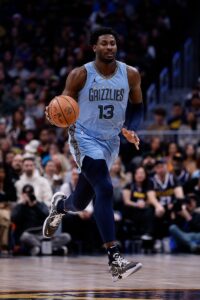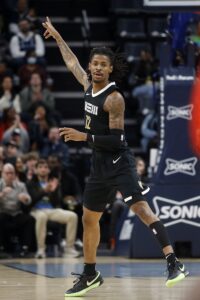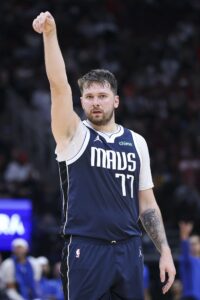The Grizzlies won 56 games in 2021/22 and 51 games in ’22/23, entering the playoffs as the West’s No. 2 seed on each occasion. However, they didn’t find much playoff success, winning one series over those two seasons despite compiling 107 regular season victories.
Entering ’23/24, expectations were a little lower, with a projected win total of 46.5. Memphis finished nowhere near that mark, going 27-55, the seventh-worst record in the NBA.
A big part of the reason why the Grizzlies’ projected win total was lower in October was star point guard Ja Morant had to serve a 25-game suspension following another off-court incident involving a firearm. After serving the suspension and playing nine games, Morant sustained a labral tear in his right shoulder after a training session in January. At the time of his surgery, the recovery was outlined as a six-month process; he’s reportedly making good progress.
Brandon Clarke‘s season was also essentially a wash. He returned in late March after sustaining a torn Achilles tendon in March 2023 and looked pretty good in his six games, but the team’s season was over by that point.
Starting center Steven Adams missed the entire season after undergoing knee surgery in October and was traded to Houston ahead of the February deadline. Marcus Smart, who was acquired in a three-team trade last summer (Memphis gave up Tyus Jones and two-first round picks), was limited to just 20 games due to a variety of injuries. The team’s best player in ’23/24, Desmond Bane, appeared in just just 42 games. The list goes on.
There were a couple bright spots amid the injury-ravaged season. Second-year wing Vince Williams had an unexpected breakout, earning a promotion from a two-way deal to a multiyear standard contract (he was also limited to 52 games due to injuries). And rookie GG Jackson, another former second-round pick who was converted to a standard deal, had a big second half, earning a spot on the All-Rookie Second Team in the process.
With Morant, Bane and Jaren Jackson Jr. all under contract for at least the next two seasons, the Grizzlies still have a window to build around their three best players. But with Bane no longer on his rookie contract (his near-max rookie scale extension kicks in next season), their financial situation will be trickier to manage going forward.
The Grizzlies’ Offseason Plan
 Memphis experimented with using Jackson more at center in ’23/24, with mixed results. Having him more involved in pick-and-rolls defensively meant he couldn’t be a weak-side roamer, which is what he’s best at. He can also be overpowered by bigger centers and is a subpar rebounder for a big man.
Memphis experimented with using Jackson more at center in ’23/24, with mixed results. Having him more involved in pick-and-rolls defensively meant he couldn’t be a weak-side roamer, which is what he’s best at. He can also be overpowered by bigger centers and is a subpar rebounder for a big man.
Offensively, Jackson can theoretically space the floor (he only made 32.0% of his threes last season; he’s at 34.5% for his career), and he’s quicker than most centers, which enables him to drive and draw fouls. It’s essentially a trade-off of offense for defense, but it isn’t a particularly fruitful one.
Jackson was the league’s Defensive Player of the Year in ’22/23. In ’23/24, he received no votes for the All-Defensive First Team and one for the Second Team. Obviously, utilizing him in a more effective way on that end is critical to the team’s success.
The Grizzlies fell two spots in the draft lottery and wound up with the No. 9 overall pick. After trading Adams and Xavier Tillman, center is a clear roster weakness, but the draft is light on big men who project to be available at that spot.
Do the Grizzlies really want to add another 19- or 20-year-old to a relatively young team that’s trying to win now? Unless they try to move up to snag a true center like Donovan Clingan, I think it’s probably more likely that they’ll trade their lottery pick for immediate help than keep it (they also control two second-rounders at No. 39 and No. 57).
If Memphis exercises its $14.8MM team option on Luke Kennard, the team would have 13 players with guaranteed deals and a team salary of approximately $172.5MM, including the dead-money cap hit of Kennedy Chandler. If the Grizzlies keep the No. 9 pick, that figure rises to about $178.2MM.
The projected luxury tax line for ’24/25 is $171.3MM. The first apron is at $178.7MM. If the Grizzlies pick up that option on Kennard, they would lose access to the non-taxpayer mid-level exception (which starts at $12.86MM) and the bi-annual exception ($4.68MM). Instead, they would have the taxpayer MLE ($5MM).
On the other hand, declining the option could mean losing a productive role player and a useful mid-sized salary for trade purposes. Kennard is one of the league’s best shooters — his 43.9% career mark on three-pointers is tops among active players, and third-best all-time. He’s also a decent tertiary play-maker and moves the ball well. The problem is he’s a below-average defender, a weakness that tends to be exploited more in the playoffs.
The Grizzlies already have Morant, Bane and Smart on the roster. Would Kennard even be part of closing lineups? On offense, sure, he could be used in place of Smart, but wasting timeouts on offense-for-defense substitutions isn’t really a great strategy at the end of games.
Is this team, as currently constructed, worth paying the tax for? Probably not. But with a small tweak or two, it could be.
Let’s say the Grizzlies decline the option and use the non-taxpayer MLE to sign a free agent center or two. Nic Claxton will be out of their price range. The Knicks could just use their Early Bird rights on Isaiah Hartenstein to outbid Memphis if the Grizzlies offer him the full MLE.
The remaining list of free agent centers doesn’t inspire a ton of confidence. Former Grizzly Jonas Valanciunas remains highly productive as a post scorer and rebounder, but he’s 32 and struggles defensively. If they split the MLE, they might be able to sign both Andre Drummond and Goga Bitadze — I don’t hate the idea as a temporary solution, but I also don’t think it would help them contend for a championship.
If he actually becomes available this summer, Cavaliers center Jarrett Allen looks like a terrific fit for this roster. I imagine he would be near the top of the Grizzlies’ list of potential trade targets.
Allen is on a relatively team-friendly contract that will pay him $20MM each of the next two seasons. He’s 26, right around the age of Memphis’ top three players. He’s a strong defender who would be an athletic lob threat to pair with Morant. The former All-Star wouldn’t come cheap in a trade, but the Grizzlies have the pieces to pursue him.
Would the No. 9 pick, Clarke or Kennard, and a young, cost-controlled player who can contribute (like Williams or Jackson) be enough to get it done? (Another contract might be needed for salary-matching purposes.) The Cavs would probably counter by asking for a second first-rounder, since the Grizzlies control all of their future first-round picks, but Cleveland would at least have to consider it. Of course, the Cavs are trying to compete for a championship too, which makes the 2024 lottery pick less appealing unless they can flip it for win-now help.
If healthy, the Grizzlies have the framework of a good team — they went 6-3 in games Morant played last season, though that’s a small sample and it isn’t a given that he’ll stay out of trouble going forward. The problem is, “good” isn’t good enough in the West — the Pelicans won 49 games and were unable to avoid the play-in tournament. Memphis can’t just run it back with its current roster and hope for better health luck. The Grizzlies will need to improve this summer if they want to be a legitimate contender.
Salary Cap Situation
Guaranteed Salary
 Ja Morant ($36,725,670)
Ja Morant ($36,725,670)- Desmond Bane ($34,005,250)
- Jaren Jackson Jr. ($25,257,798)
- Marcus Smart ($20,210,285)
- Brandon Clarke ($12,500,000)
- John Konchar ($6,165,000)
- Ziaire Williams ($6,133,005)
- Santi Aldama ($3,960,531)
- Derrick Rose ($3,356,271)
- Jake LaRavia ($3,352,680)
- Vince Williams ($2,120,693)
- GG Jackson ($1,891,857)
- Total: $155,679,040
Non-Guaranteed Salary
Dead/Retained Salary
Player Options
Team Options
Restricted Free Agents
Two-Way Free Agents
Draft Picks
- No. 9 overall pick ($5,773,800 cap hold)
- No. 39 overall pick (no cap hold)
- No. 57 overall pick (no cap hold)
- Total (cap holds): $5,773,800
Extension-Eligible Players
- Santi Aldama (rookie scale)
- Jaren Jackson Jr. (veteran)
- Extension-eligible as of October 1.
- Luke Kennard (veteran)
- Extension-eligible until June 30 (or beyond, if his team option is exercised).
- Marcus Smart (veteran)
- Ziaire Williams (rookie scale)
Note: Unless otherwise indicated, these players are eligible for extensions beginning in July.
Unrestricted Free Agents
Other Cap Holds
- Yves Pons ($1,867,722 cap hold)
- Total (cap holds): $1,867,722
Note: Pons’ cap hold is on the Grizzlies’ books from a prior season because he hasn’t been renounced. He can’t be used in a sign-and-trade deal.
Cap Exceptions Available
Note: The Grizzlies project to operate over the cap and under the first tax apron. If they approach or exceed the first apron, they would lose access to the full mid-level exception and bi-annual exception and would gain access to the taxpayer mid-level exception ($5,183,000).
- Non-taxpayer mid-level exception: $12,859,000
- Bi-annual exception: $4,681,000
- Trade exception: $12,600,000
- Trade exception: $7,492,540
- Trade exception: $2,718,240
- Trade exception: $1,930,681
Note: Unless otherwise indicated, trade exceptions don’t expire before the regular season begins.
Luke Adams contributed to this post.

 Memphis experimented with using Jackson more at center in ’23/24, with mixed results. Having him more involved in pick-and-rolls defensively meant he couldn’t be a weak-side roamer, which is what he’s best at. He can also be overpowered by bigger centers and is a subpar rebounder for a big man.
Memphis experimented with using Jackson more at center in ’23/24, with mixed results. Having him more involved in pick-and-rolls defensively meant he couldn’t be a weak-side roamer, which is what he’s best at. He can also be overpowered by bigger centers and is a subpar rebounder for a big man.